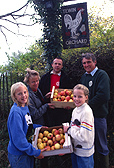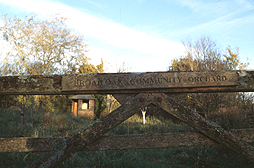![]() The Orchards Path
The Orchards Path
Restoring Old Orchards For Community Use


Since Common Ground first promoted the idea in 1992, many Community Orchards have been created by trusts, parish councils, local authorities and voluntary bodies. Here are some further examples of old orchards which have been restored or nurtured by local people for diverse ends:
Tewin Orchard
Tewin Orchard, near Welwyn Garden City in Hertfordshire (top, left), is managed by the Herts & Middlesex Wildlife Trust and is leased from the RSPB. It was one of the first orchard nature reserves, attracting a wide variety of butterflies and birds. Many of its original trees date back to planting in 1933. Restocking of Hertfordshire fruit varieties has continued over recent years. In 1998, following the formation of the Hertfordshire Orchards Initiative, Tewin Orchard started hosting budding and grafting courses and began a rootstock nursery which will supply new local Community Orchards.
The Nuttery
The Nuttery in Northamptonshire comprises 0.6 hectares of hazel coppice that has been given to the Woodland Trust. Hazel nuts and snowdrops have been grown commercially at the Nuttery for at least a hundred years. A squeeze gate has been built to give access at all. There are open days in spring and autumn for the picking and sale of snowdrops and nuts.
Cleeve Prior Parish Ponds and Community Orchard
Cleeve Prior Parish Ponds and Community Orchard project in Worcestershire was initiated by Don and Linda Warren who have lived in Cleeve Prior, near Evesham, since 1975. It all began with a village recycling scheme and the formation of the Cleeve Prior Heritage Trust in 1997 with a listed barn as a focus for their activities. Next, the Warrens and other trust members set about acquiring and restoring 2.4 hectares of old orchard, which included Lord Lambourne and Beauty of Bath apples, Damascenes (Shropshire damsons), Victoria, Pershore Yellow Egg, Rivers Early Prolific and other plums and cherries, as well as derelict fish ponds adjacent to the barn. The orchard had been part of an intensively cultivated patchwork of small strips since the 1920s. In recent years, many of these orchards have been grubbed out and planted with grain or have been developed and what remained was neglected. Twice-weekly work-parties, usually attracting around 12 villagers, have succeeded in clearing much of the thick scrub from the orchard and from around the newt-laden ponds. The aim is to gradually replant the orchard with local, historically important varieties and a greater diversity of fruits. A mixture of apples, including cider varieties for eventual local production have already been planted. There is plenty of scope to experiment with new ideas. In years of surplus, fruit could be picked and packed for sale to help with the costs of orchard upkeep. But much of the fruit will go to local people. Volunteers pick fruit for older people in the village and for residents of Evesham. Links with inner-city residents from Birmingham who would like to spend a day in the country picking fruit are another possibility – an historical precedent recalls the seasonal pickers who, until the 1960s, helped with the rural harvest. The orchard is also a special resource for local schools and those wishing to learn orchard skills. With the ponds and the surrounding hedges and scrub, many species of wild life including dragonflies, damselflies and butterflies, will be attracted to the restored orchard grassland (which contains orchids, adder’s tongue fern and centaury) and to its old trees, to feed on blossom or fallen fruit, as well as sheltering under the bark and decaying wood. The desire to build and maintain features such as signs, seats, gates and displays in the orchard and the adjacent barn and stables offers villagers a chance to contribute practical, artistic and communication skills. There is enthusiasm to be flexible and inclusive about the roles which the orchard, ponds and buildings can support. Already the orchard has inspired Linda Warren and Evesham resident, Bob Woodrofe, to poetry.
Broad Oak Community Orchard
Broad Oak Community Orchard near Sturminster Newton (top, right) is owned by the Dorset Wildlife Trust and is open all year round. Its two-thirds of a hectare contain mature apple, plum and pear trees that will reward human visitors with almost a dozen delicious varieties in autumn. In summer, its flower-rich grassland contain cowslips, creeping jenny and devil’s bit scabious. After the winter gloom the blackthorn hedge illuminates Broad Oak with early blossom. The orchard’s wilder visitors include butterflies, a host of birds including woodpeckers and treecreepers as well as ground-hugging mammals that use the grassland as foraging cover. Broad Oak is in good company: two nearby schools, in Sturminster Newton and Blandford Forum, have orchards within their grounds.
If you have a Community Orchard, please let us know -